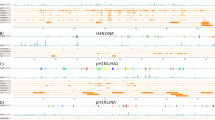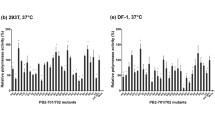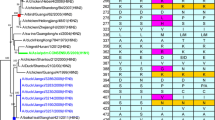Abstract
This review summarizes the locations of unique amino acid substitutions in proteins of cold-adapted influenza B viruses, master donor viruses of live attenuated influenza vaccines: B/Ann Arbor/1/66ca, B/USSR/60/69, B/Leningrad/14/17/55, B/Victoria/2/63/87, and B/Vienna/1/99ca. The analysis is based on data on the viral sequences and information on the functional organization of internal proteins of the influenza B virus. A description is given of the main features of the structure of internal proteins from influenza B virus and a recent understanding of the functioning of their domains. We describe 35 substitutions in proteins of the ribonucleoprotein complex [PB1 (3), PB2 (10), PA (11), NP (11)] of cold-adapted influenza B viruses. In total, there are 44 amino acid positions that are considered to be associated with cold adaptation. Protein domains involved in protein–protein interactions are the most susceptible to changes. In the polymerase complex, the largest number of replacements were found in C-terminal domains of PA and PB2 proteins, forming the external parts of the polymerase complex structure and providing interaction among subunits, with cellular factors, and with the nucleoprotein (NP). Substitutions in the NP are located in the areas responsible for its oligomerization (flexible N-terminal fragment), as well as for interaction with the polymerase complex (the outer surface of the NP head and body domains). All the cold-adapted viruses had changes in the seventh segment of the genome, leading to amino acid substitutions in the matrix protein or BM2 proton channel. An analysis of the location of amino acid substitutions allows it to be theorized that an important role is played by the internal gene constellation in attenuation of cold-adapted viruses.


Similar content being viewed by others
REFERENCES
Massin, P., van der Werf, S., and Naffakh, N., Residue 627 of PB2 is a determinant of cold sensitivity in RNA replication of avian influenza viruses, J. Virol., 2001, vol. 75, no. 11, pp. 5398–5404.
Isakova-Sivak, I. and Rudenko, L., Safety, immunogenicity and infectivity of new live attenuated influenza vaccines, Expert Rev. Vaccines, 2015, vol. 14, no. 10, pp. 1313–1329.
Belshe, R.B., Coelingh, K., Ambrose, C.S., et al., Efficacy of live attenuated influenza vaccine in children against influenza B viruses by lineage and antigenic similarity, Vaccine, 2010, vol. 28, no. 9, pp. 2149–2156.
Chen, Z., Aspelund, A., Kemble, G., and Jin, H., Genetic mapping of the cold-adapted phenotype of B/Ann Arbor/1/66, the master donor virus for live attenuated influenza vaccines (FluMist), Virology, 2006, vol. 345, no. 2, pp. 416–423.
Kiseleva, I.V., Voeten, J.T.M., Teley, L.C.P., et al., PB2 and PA genes control the expression of the temperature-sensitive phenotype of cold-adapted B/USSR/60/69 influenza master donor virus, J. Gen. Virol., 2010, vol. 91, part 4, pp. 931–937.
Hoffmann, E., Mahmood, K., Chen, Z., et al., Multiple gene segments control the temperature sensitivity and attenuation phenotypes of ca B/Ann Arbor/1/66, J. Virol., 2005, vol. 79, no. 17, pp. 11014–11021.
Aleksandrova, G.I., RF Patent 2068271, 1996.
Gendon, Yu.Z., Markushin, S.G., Tsfasman, T.M., et al., New cold-adapted donor strains for live influenza vaccine, Vopr. Virusol., 2013, vol. 58, no. 1, pp. 11–17.
Katinger, H., Egorov, A., Ferko, B., et al., Int. Patent WO 2002024876 A2, 2002. https://www.google.com/ patents/WO2002024876A2. Accessed July 5, 2017.
Seo, S.-U., Byun, Y.-H., Lee, E.-Y., et al., Development and characterization of a live attenuated influenza B virus vaccine candidate, Vaccine, 2008, vol. 26, no. 7, pp. 874–881.
Lee, E.-Y., Lee, K.-H., Jung, E.-J., et al., Genotyping and screening of reassortant live-attenuated influenza B vaccine strain, J. Virol. Methods, 2010, vol. 165, no. 2, pp. 133–138.
Jang, Y.H., Lee, E.-Y., Byun, Y.H., et al., Protective efficacy in mice of monovalent and trivalent live attenuated influenza vaccines in the background of cold-adapted A/X-31 and B/Lee/40 donor strains, Vaccine, 2014 vol. 32, no. 5, pp. 535–543.
Maassab, H.F. and DeBorde, D.C., Development and characterization of cold-adapted viruses for use as live virus vaccines, Vaccine, 1985, vol. 3, no. 5, pp. 355–369.
Donabedian, A.M., DeBorde, D.C., and Maassab, H.F., Genetics of A/X-31 and B/Lee/40 donor strains, Vaccine, 2014, vol. 32, no. 5, pp. 535–543.
Rudenko, L. and Alexandrova, G., Current strategies for the prevention of influenza by the Russian cold-adapted live influenza vaccine among different populations, Int. Congr. Ser., 2001, vol. 1219, pp. 945–950.
Alexandrova, G.I., Maassab, H.F., Kendal, A.P., et al., Laboratory properties of cold-adapted influenza B live vaccine strains developed in the US and USSR, and their B/Ann Arbor/1/86 cold-adapted reassortant vaccine candidates, Vaccine, 1990, vol. 8, no. 1, pp. 61–64.
Resa-Infante, P., Jorba, N., Coloma, R., and Ortín, J., The influenza RNA synthesis machine, RNA Biol., 2011, vol. 8, no. 2, pp. 207–215.
Liu, Y., Yang, Y., Fan, J., et al., The crystal structure of the PB2 cap-binding domain of influenza B virus reveals a novel cap recognition mechanism, J. Biol. Chem., 2015, vol. 290, no. 14, pp. 9141–9149.
Reich, S., Guilligay, D., Pflug, A., et al., Structural insight into cap-snatching and RNA synthesis by influenza polymerase, Nature, 2014, vol. 516, no. 7531, pp. 361–366.
Pflug, A., Guilligay, D., Reich, S., and Cusack, S., Structure of influenza A polymerase bound to the viral RNA promoter, Nature, 2014, vol. 516, no. 7531, pp. 355–360.
Massin, P., van der Werf, S., and Naffakh, N., Residue 627 of PB2 is a determinant of cold sensitivity in RNA replication of avian influenza viruses, J. Virol., 2001, vol. 75, no. 11, pp. 5398–5404.
Subbarao, E.K., London, W., and Murphy, B.R., A single amino acid in the PB2 gene of influenza A virus is a determinant of host range, J. Virol., 1993, vol. 67, no. 4, pp. 1761–1764.
Boivin, S., Cusack, S., Ruigrok, R.W.H., and Hart, D.J., Influenza A virus polymerase: structural insights into replication and host adaptation mechanisms, J. Biol. Chem., 2010, vol. 285, no. 37, pp. 28411–28417.
He, X., Zhou, J., Bartlam, M., et al., Crystal structure of the polymerase PA(C)-PB1(N) complex from an avian influenza H5N1 virus, Nature, 2008, vol. 454, no. 7208, pp. 1123–1126.
Obayashi, E., Yoshida, H., Kawai, F., et al., The structural basis for an essential subunit interaction in influenza virus RNA polymerase, Nature, 2008, vol. 454, no. 7208, pp. 1127–1131.
Ng, A.K.-L., Lam M.K.-H., Zhang H., et al., Structural basis for RNA binding and homo-oligomer formation by influenza B virus nucleoprotein, J. Virol., 2012, vol. 86, no. 12, pp. 6758–6767.
Liu, M, Lam, M.K.-H., Zhang, Q., et al., The functional study of the N-terminal region of influenza B virus nucleoprotein, PLoS One, 2015, vol. 10, no. 9, p. e0137802.
Wanitchang, A., Narkpuk, J., and Jongkaewwattana, A., Nuclear import of influenza B virus nucleoprotein: involvement of an N-terminal nuclear localization signal and a cleavage-protection motif, Virology, 2013, vol. 443, no. 1, pp. 59–68.
Hatta, M., Kohlmeier, C.K., Hatta, Y., et al., Region required for protein expression from the stop-start pentanucleotide in the M gene of influenza B virus, J. Virol., 2009, vol. 83, no. 11, pp. 5939–5942.
Safo, M.K., Musayev, F.N., Mosier, P.D., et al., Crystal structures of influenza A virus matrix protein M1: Variations on a theme, PLoS One, 2014, vol. 9, no. 10, p. e109510.
Cao, S., Jiang, J., Li, J., et al., Characterization of the nucleocytoplasmic shuttle of the matrix protein of influenza B virus, J. Virol., 2014, vol. 88, no. 13, pp. 7464–7473.
Biasini, M., Bienert, S., Waterhouse, A., et al., SWISS-MODEL: Modelling protein tertiary and quaternary structure using evolutionary information, Nucleic Acids Res., 2014, vol. 42, no. 1, pp. 252–258.
Wang, J., Pielak, R.M., McClintock, M.A., and Chou, J.J., Solution structure and functional analysis of the influenza B proton channel, Nat. Struct. Mol. Biol., 2009, vol. 16, no. 12, pp. 1267–1271.
Wakefield, L. and Brownlee, G.G., RNA-binding properties of influenza A virus matrix protein M1, Nucleic Acids Res., 1989, vol. 17, no. 21, pp. 8569–8580.
Sha, B. and Luo, M., Structure of a bifunctional membrane-RNA binding protein, influenza virus matrix protein M1, Nat. Struct. Biol., 1997, vol. 4, no. 3, pp. 239–244.
Arzt, S., Baudin, F., Barge, A., et al., Combined results from solution studies on intact influenza virus M1 protein and from a new crystal form of its N-terminal domain show that M1 is an elongated monomer, Virology, 2001, vol. 279, no. 2, pp. 439–446.
Shtykova, E.V., Baratova, L.A., Fedorova, N.V., et al., Structural analysis of Influenza A virus matrix protein M1 and its self-assemblies at low pH, PLoS One, 2013, vol. 8, no. 12, p. e82431.
Shishkov, A., Bogacheva, E., Fedorova, N., et al., Spatial structure peculiarities of influenza A virus matrix M1 protein in an acidic solution that simulates the internal lysosomal medium, FEBS J., 2011, vol. 278, no. 24, pp. 4905–4916.
Zhang, K., Wang, Z., Liu, X., et al., Dissection of influenza A virus M1 protein: pH-dependent oligomerization of N-terminal domain and dimerization of C‑terminal domain, PLoS One, 2012, vol. 7, no. 5, p. e37786.
Zhang, K., Wang, Z., Fan, G.-Z., et al., Two polar residues within C-terminal domain of M1 are critical for the formation of influenza A virions, Cell. Microbiol., 2015, vol. 17, no. 11, pp. 1583–1593.
Yin, C., Khan, J.A., Swapna, G.V.T., et al., Conserved surface features form the double-stranded RNA binding site of non-structural protein 1 (NS1) from influenza A and B viruses, J. Biol. Chem., 2007, vol. 282, no. 28, pp. 20584–20592.
Wang, W. and Krug, R.M., The RNA-binding and effector domains of the viral NS1 protein are conserved to different extents among influenza A and B viruses, Virology, 1996, vol. 223, no. 1, pp. 41–50.
Guan, R., Ma, L.-C., Leonard, P.G., et al., Structural basis for the sequence-specific recognition of human ISG15 by the NS1 protein of influenza B virus, Proc. Natl. Acad. Sci. U. S. A., 2011, vol. 108, no. 33, pp. 13468–13473.
Ma, L.-C., Guan, R., Hamilton, K., et al., A second RNA-binding site in the NS1 protein of influenza B virus, Structure, 2016, vol. 24, no. 9, pp. 1562–1572.
Dauber, B., Schneider, J., and Wolff, T., Double-stranded RNA binding of influenza B virus nonstructural NS1 protein inhibits protein kinase R but is not essential to antagonize production of alpha/beta interferon, J. Virol., 2006, vol. 80, no. 23, pp. 11667–11677.
Imai, M., Watanabe, S., and Odagiri, T., Influenza B virus NS2, a nuclear export protein, directly associates with the viral ribonucleoprotein complex, Arch. Virol., 2003, vol. 148, no. 10, pp. 1873–1884.
Paragas, J., Talon, J., O’Neill, R.E., et al., Influenza B and C virus NEP (NS2) proteins possess nuclear export activities, J. Virol., 2001, vol. 75, no. 16, pp. 7375–7383.
Cha, T.-A., Kao, K., Zhao, J., et al., Genotypic stability of cold-adapted influenza virus vaccine in an efficacy clinical trial, J. Clin. Microbiol., 2000, vol. 38, no. 2, pp. 839–845.
Kiseleva, I.V., Klimov, A.I., Grigor’eva, E.P., et al., Genetic and phenotypic analysis of heterogeneous population of A/Leningrad/134/17/57 (H2N2) cold-adapted donor of the attenuation and donor-based reassortant influenza vaccine strains, Vopr. Virusol., 2005, vol. 50, no. 2, pp. 14–18.
Buonagurio, D.A., Bechert, T.M., Yang, C.-F., et al., Genetic stability of live, cold-adapted influenza virus components of the FluMist/CAIV-T vaccine throughout the manufacturing process, Vaccine, 2006, vol. 24, no. 12, pp. 2151–2160.
Buonagurio, D.A., O’Neill, R.E., Shutyak, L., et al., Genetic and phenotypic stability of cold-adapted influenza viruses in a trivalent vaccine administered to children in a day care setting, Virology, 2006, vol. 347, no. 2, pp. 296–306.
Murphy, B.R., Park, E.J., Gottlieb, P., and Subbarao, K., An influenza A live attenuated reassortant virus possessing three temperature-sensitive mutations in the PB2 polymerase gene rapidly loses temperature sensitivity following replication in hamsters, Vaccine, 1997, vol. 15, nos. 12–13, pp. 1372–1378.
Treanor, J.J., Buja, R., and Murphy, B.R., Intragenic suppression of a deletion mutation of the nonstructural gene of an influenza A virus, J. Virol., 1991, vol. 65, no. 8, pp. 4204–4210.
Author information
Authors and Affiliations
Corresponding author
Additional information
Translated by M. Novikova
About this article
Cite this article
Stepanova, E.A., Krutikova, E.V., Kiseleva, I.V. et al. The Spatial Location of Single Amino Acid Substitutions in Proteins of Cold-Adapted Influenza B Viruses and Their Impact upon Cold Adaptation. Mol. Genet. Microbiol. Virol. 33, 169–181 (2018). https://doi.org/10.3103/S0891416818030060
Received:
Published:
Issue Date:
DOI: https://doi.org/10.3103/S0891416818030060




